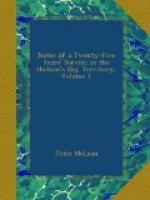The complexion of the Esquimaux is swarthy; I have seen some of their children, however, as fair as the children of the fairest people in Europe, yet these become as dark as their parents when advanced in years. This circumstance cannot be accounted for by filthiness or exposure to the weather; for I have observed, on the coast of Labrador, the descendants of an Esquimaux mother and a European father of the third generation as dark as the pure Esquimaux; and these, too, enjoyed the comforts of civilized life, were cleanly in their persons, and not more exposed to the weather than others.
The Esquimaux are low of stature, but I do not think the epithet “dwarfish” applies to them with propriety. With the view of ascertaining this point, I once took five men promiscuously from a party of twenty, and found their average height to be 5 feet 5 inches. Some individuals of the remainder measured 5 feet 7 or 8 inches, and one exceeded 6 feet. The fact is, the Esquimaux are generally thicker than Europeans; their peculiar dress also adds greatly to their bulk, so that they appear shorter than they really are. They are so bound up in their seal-skin garments that their movements are necessarily much impeded by them, we can, therefore, form no idea of their agility; but I do not hesitate to say that their strength exceeds that of any other nation on the continent.
The Esquimaux features are far from being disagreeable; some females I observed among them whose expression of countenance was extremely prepossessing, and who would pass for “bonnie lasses” even among the whites, if divested of their filth and uncouth dress, and rigged out in European habiliments. The women fasten their hair in a knot on the crown of the head, and anoint it with rancid oil in lieu of pomatum; they also tattoo their faces, with the view, no doubt, of enhancing their charms in the estimation of their blubber-eating lovers. Their teeth are remarkably white and regular; the eyes are black, and partake more of the circular than the oval form; the cheek-bones are prominent, forehead low, mouth large, and chin pointed.
The Esquimaux generally enjoy good health, and no epidemic diseases, as far as I could learn, are known among them.
CHAPTER XI.
LABRADOR—ESQUIMAUX HALF-BREEDS—MORAVIAN BRETHREN—EUROPEAN INHABITANTS—THEIR VIRTUES—CLIMATE—ANECDOTE.
The country denominated Labrador, extends from Esquimaux Bay, on the Straits of Belleisle, to the extremity of the continent, Cape Chudleigh, at the entrance of Hudson’s Strait. The interior is inhabited by two tribes of Indians, Mountaineers and Nascopies, members of the Cree family. The coast was inhabited at one time by Esquimaux only, but the southern part is now peopled by a mongrel race of Esquimaux half-breeds, a few vagabond Esquimaux, and some English and Canadian fishermen and trappers, who are assimilated to the




